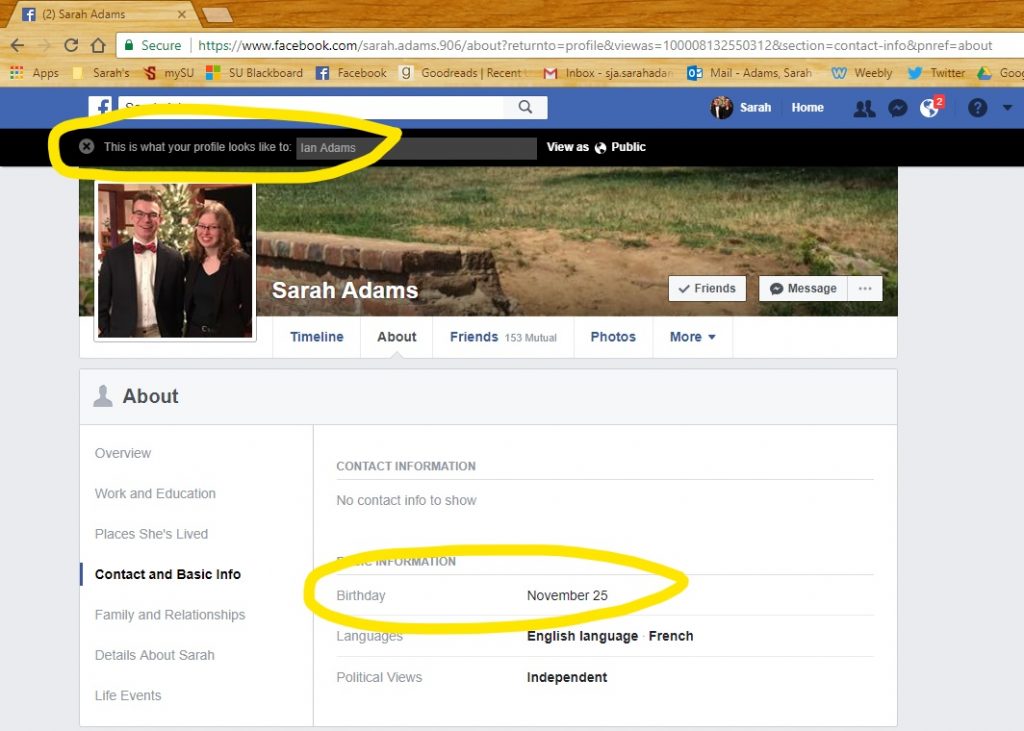Keira’s post about social media got me thinking about audience, especially in light of Writer/Designer’s first chapter. Due to the digital nature of social media, it often seems to have a wider, more uncontrollable audience than something in print. For example, many of us have been told—or, in most cases, lectured—from a young age that once you post something online (a comment, a status, a nude) then it’s lost to the internet forever. Because of this, when I was in ninth grade and finally persuaded my parents to let me create a Facebook account, they didn’t let me put my birthyear on my profile. “November 25th” was fine, but heaven forbid that my Facebook page tell people I was born in 1996.

Other people have told me that they weren’t allowed to upload pictures of themselves or list their last name when they first made their Facebook profiles. Though they might have seemed excessive at the time, all of these parental precautions were an attempt to predict audiences that could potentially take advantage of personal information. Fortunately, social media platforms like Facebook or Twitter do provide us with some ways to control our audiences: Tweets can be “protected” so that the public doesn’t see them, and Facebook statuses can be made available to just friends, or friends of friends, or certain friends but not other friends, or the entire public. (Or, that is, the entire Facebook-using public.) For example, if I want to post a left-leaning political status without starting some sort of flame war with my conservative friends, I can choose to exclude potential troublemakers from my audience. Or, if I want to post a despair-filled, angst-ridden status, I can exclude my mother so that she does not get concerned and text me about my wellbeing.
This is one way that digital platforms differ from print ones. We reach and restrict audiences in very different ways when working online. For example, as one previous post mentioned, digital publishing sometimes allows us to reach more people by sidestepping traditional gatekeeping systems. In other cases, as in the examples I mentioned above, we can limit the number of people who see our content. However, nothing is foolproof. Thus, when we post something online—and for the sake of this exercise, let’s assume it’s something innocent and not, like, a sex tape—there is no way to guarantee what exact audience we might reach. We don’t know if someone blind might be interested in our content, or if someone who is a non-native English speaker might want to access it.
As a result, we need to learn to anticipate potential audiences. This is something that the first chapter of Writer/Designer spends a lot of time discussing: “When creating multimodal texts, authors should always remember that not every reader will be exactly like them, whether in culture, society, class, race, gender, or ability” (Arola 20). Because digital publishing explores and encourages us to use various types of media, it provides us with multiple tools to address a diverse audience. In this way, I think digital publishing improves accessibility—not necessarily because print publishing can’t get the job done, but because the multimodal nature of digital publishing urges us to think in new, creative ways.
As I started to read Writer/Designer, one of the most interesting things I noticed was that the text itself takes this question of audience into consideration. For example, it acknowledges that you might not always (or ever) like its use of memes—“There may be images in this book that you don’t like—such as the lolcat on the first page.” It also attempts to predict readers’ potential disdain for “hateful and mean-spirited” texts, reassuring them in a parenthetical, “Don’t worry: We won’t be showing any hateful texts in this book!” (Arola 7). Writer/Designer is a book that practices what it preaches: although it cannot account for every person who might read it, it (or rather, its authors, I suppose) attempts to take as many people into account as possible. It makes me wonder if a textbook coming from a different discipline—one for which the questions of media and audience are not so pertinent—would be written the same way; I suspect the answer is that it would not be.
Word count: 756
Works Cited:
Arola, Kristin L., et al. Writer/Designer: A Guide to Making Multimodal Projects. Bedford/St. Martin’s, 2018.